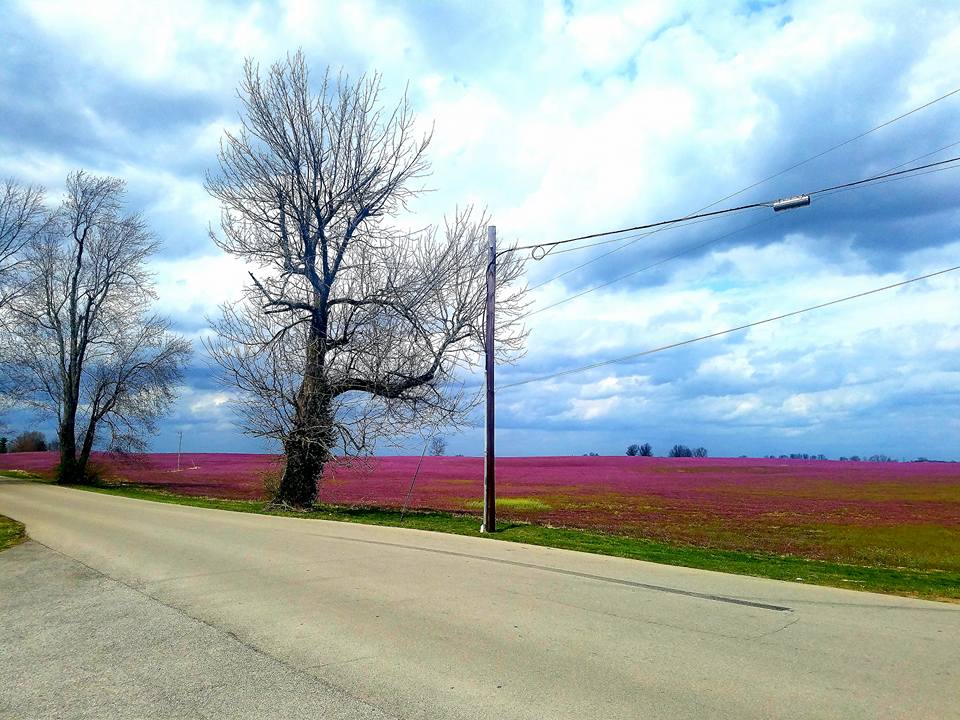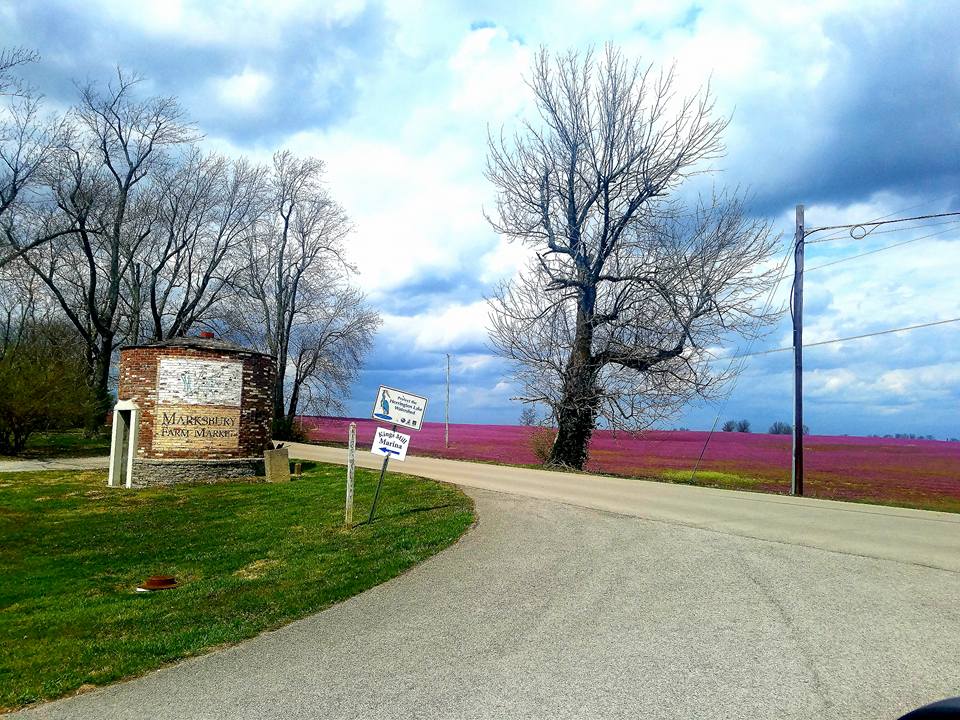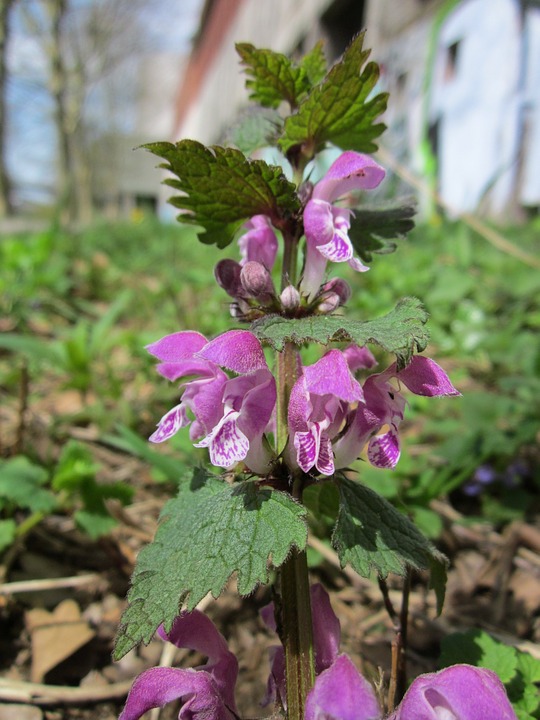Ahhhh, what are those GORGEOUS purple flowers that are covering that field??? Well, they just might be PURPLE DEAD NETTLE.
Have you ever been driving down a country road in MARCH and see fields of purple as far as the eye could see? As you can see in the photos in this article, there is plenty of PURPLE DEAD NETTLE (to be found in Kentucky. I took these photos in April near my home. GORGEOUS to the eye when in full purple bloom, but the leaves are kind of purplish green and dull when matured…..This plant is normally found in the Northern hemisphere between the months of April – October.
You might wonder why it is named ‘DEAD’ nettle? Well, that answer lies in the fact that STINGING NETTLE literally STINGS, yet, this nettle has soft hairs on its leaves and doesn’t harm the skin when touched. It originated in Europe.
However, the health benefits of these plants are many. PURPLE DEAD NETTLE ( Lamium purpureum) is known to be a diuretic (causing increased urine), an astringent (constricts skin cells/pores), a purgative (laxative like effect), a diaphoretic (causes sweating), and even known to be a styptic (causes bleeding to stop when applied to wounds). Add it to poultice recipes. …The fresh LEAVES of this plant can be used on external wounds or cuts. Yes, that pretty little flowering plant is beneficial if you know how to use it. (A poultice can be made by crushing fresh leaves onto a cotton bandage and securing the bandage to the wound area). It’s that simple.
I harvest and dry the leaves each spring and keep them in a labeled jar. Having them in a jar in my pantry makes it so nice to add PURPLE DEAD NETTLE LEAVES to green smoothies, add to soups (cold & hot), quiches, tea blends, sprinkle them on my eggs, add to salads, etc… I use the fresh leaves for salad greens in the Spring. I also keep dried leaves for spice and rub blends. They don’t have a bold taste, but the nutrients are great. Remember, DRIED leaves are MUCH stronger than the FRESH leaves….The strength factor of components is like a 1:3 ratio (dried vs fresh). At least this is what I’ve always been told by my grandmother.
This little ‘wonder’ plant can be used as an ANTI-INFLAMMATORY, ANTI-FUNGAL, & ANTI-BACTERIAL. This plant is part of the MINT FAMILY of plants…. It’s young leaves can be eaten freshly picked by adding to SPRING SALADS. Note that the tiny ‘hairs’ on the leaves do not sting as they do on its COUSIN, ‘STINGING NETTLE’………
Many of this plants benefits are similar to PLANTAIN LEAF benefits. Especially, when used to stop bleeding and wound healing. It is packed with vitamins. Vitamin C is one of those vitamins, as well as having iron & fiber. <3


Let us start with a nice PURPLE DEAD NETTLE TEA recipe.
___________________________________________________________________________
PURPLE DEAD NETTLE TEA
5 Tbsp. Dried PURPLE DEAD NETTLE LEAVES
10 oz Distilled Water
Place dried PURPLE DEAD NETTLE leaves in water in saucepan until they come to a boil. Turn off burner and allow to steep for 10 minutes. Strain leaves and add sweetener to the tea according to your taste. I use MONK FRUIT sweetener, but you can use ORGANIC STEVIA, if you want.
___________________________________________________________________________

___________________________________________________________________________
PURPLE DEAD NETTLE TINCTURE
Fill a pint size mason jar with fresh, clean PURPLE DEAD NETTLE LEAVES.
Fill the jar by pouring EVERCLEAR GRAIN ALCOHOL (190 PROOF) over the top of the PURPLE DEAD NETTLE LEAVES. Place a lid on the top and seal the jar well. Leave in a dry, cool, dark place. I usually sit mine in my cabinet and shake occasionally over the next 6 weeks.
In 6 weeks, strain the plant material out of the tincture, bottle into smaller dropper size bottles and label well.
You can use externally or internally. Drop a few drops under the tongue, hold for about 2 minutes and swallow. You can also use drops externally for wounds or bug bites. I put the drops on a bandaid to assist in healing.
**Always ask your doctor before using any product whether topically or internally.
___________________________________________________________________________
Keep in mind that there is another plant that is a ‘look-alike’ to PURPLE DEAD NETTLE. Its called HENBIT (Lamium amplexicaule ) and it has leaves that are a bit more GREEN, whereas, PURPLE DEAD NETTLE
(Lamium purpureum) have leaves that are more of a purplish green and grow in clumps, as opposed to the heart-shaped, scalloped edged leaves of HENBIT. Whereas, the PURPLE DEAD NETTLE leaves are triangular in shape. So, don’t freak if you get HENBIT because both are edible.
Below, I have posted a photo of HENBIT. It’s hard to tell the difference between HENBIT & PURPLE DEAD NETTLE unless you know the leaf properties. These plants are native to Europe, Asia, & Africa.

(Lamium amplexicaule)
Often confused for PURPLE DEAD NETTLE.
Both have edible LEAVES.
Although PURPLE DEAD NETTLE & HENBIT can be eaten by humans, it does cause some concerns in birds & animals. Cows, horses, & sheep can have ‘dizzy’ spells after eating this plant. They seem to naturally avoid the plant. However, rabbits & chickens find it quite appealing. Hummingbirds LOVE the nectar from the flowers of both plants.
As many of you know, I love the bees. I had my own hives for a time period and used the venom for therapy purposes. In the early Spring, the bees don’t have many options for nectar. PURPLE DEAD NETTLE & HENBIT flowers make for a perfect nectar source for the bees.
___________________________________________________________________________
EARLY SPRING SALAD
Bunch of fresh PURPLE DEAD NETTLE LEAVES ….TORN APART
Bunch of fresh DANDELION Leaves…CHOPPED
Early homegrown LETTUCE……TORN APART
1 small bunch of CILANTRO leaves diced…..DICED
Hand full of Pine Nuts to sprinkle throughout the greens.
3 DICED Tomatoes
FETA Cheese crumbled & sprinkled throughout the mix.
__________________________________
DRESSING:
6 Avocados…SCOOPED into a large mixing bowl
5 TBSP Honey
Lemon or Lime Juice
Himalayan Salt to taste
Mix together well until creamy. Add more Lime Juice to make creamier. Drizzle over fresh green salad.
___________________________________________________________________________
Note that we are all individual and unique. Therefore, there is always a chance of toxicity or allergic reactions when ingesting or topically using any plant or product. Be cautious, research yourself, ask your physician, and know that your actions are of your own accord. NO ONE is responsible for your actions except you. Extensive research has not been done on these recipes shown within this blog. I take no responsibility for your decision to ingest or use topically any of the recipes herein. Test your reaction to all plants before you use any plant or product without caution. ALL content in this blog is for educational purposes only. You MUST consult with your physician before following any of the content herein this blog. I am only sharing generalities for educational purposes. I am NOT a physician, scientist, nor your Momma…..Be Cautious!